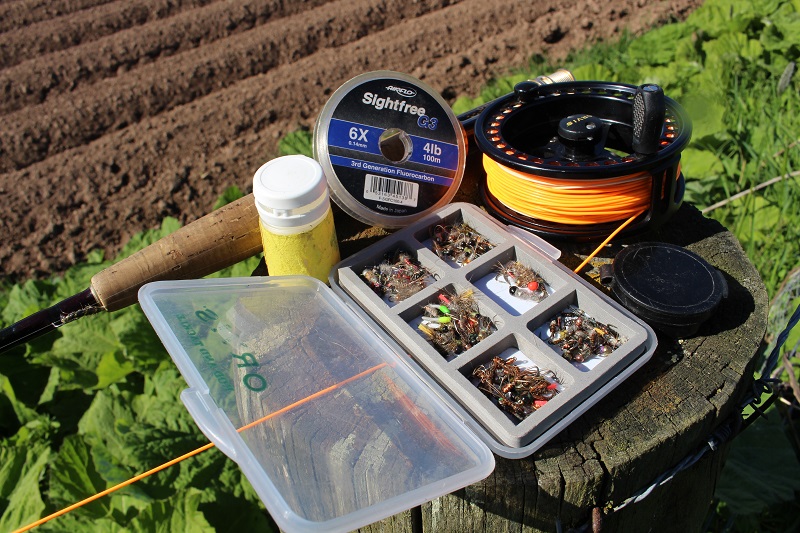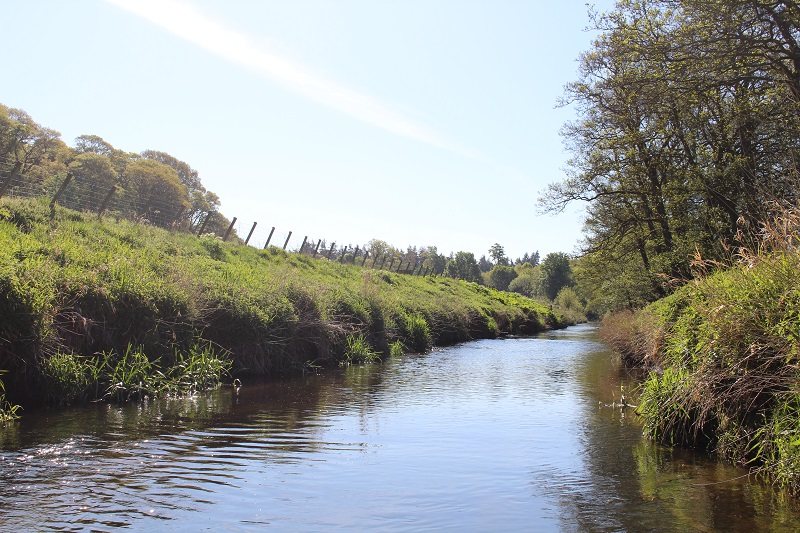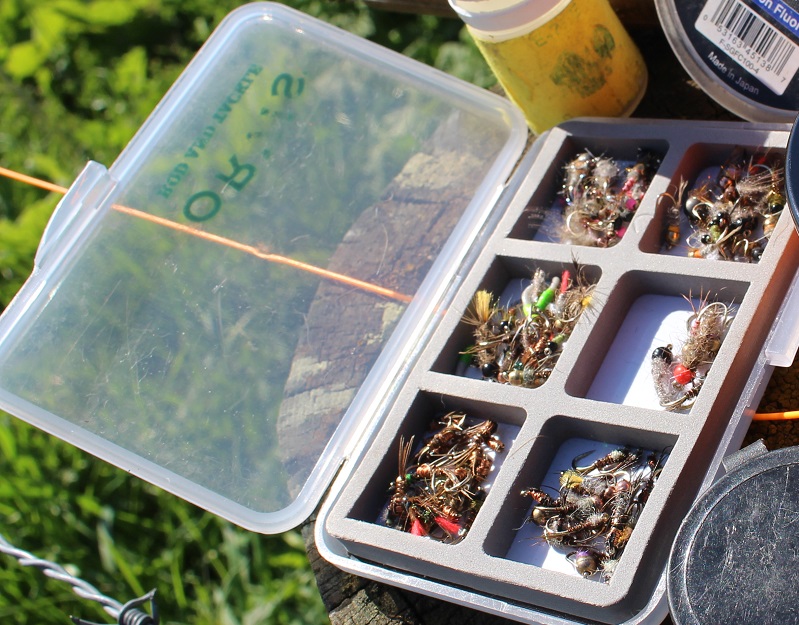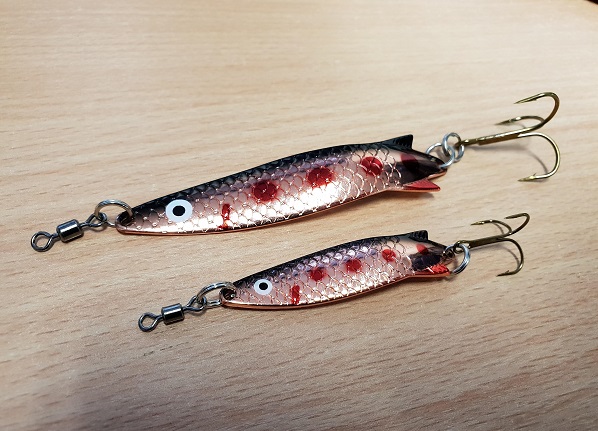At this time of year, I like to put the pike and streamer gear away and get a few weeks fishing on the local burns that are within cycling distance of my home.
Fishing these little burns and rivers provide us anglers a multitude of fishing opportunities. These little waterways carve themselves through the length and breadth of the country and the thrill of their unknown potential always heightens my curiosity.

This combat style of fishing is not for the faint-hearted and consists of crawling through nettles and dense vegetation, flies hung up on trees and bushes and covering a lot of miles but I personally love the exploring aspect of it. It takes me back to my childhood days, chasing brown trout with docken grubs, cased caddis and stone clingers but these days I tend to use a fly rod.
Like any of my fishing, I try to handpick the days that give me the best chance of a hatch, opting for overcast and warm conditions with as little wind as possible. These conditions will also favour casting in such a confined area. Trying to land a fly in a 3ft wide run is hard enough without a strong downstream wind hitting you in the face.
As for equipment, I travel as light as possible, only taking the bare essentials.
The rod I use is a 9ft 3 or 4 weight with a reel to match, loaded with a weight forward line, a couple of really slim fly boxes, one accommodating spider patterns, one with dries and one with nymphs.

A spool of fluorocarbon and a spool of mono in 3 and 4lb breaking strain, a tub of Fuller’s mud, a bottle of gink, a small waterproof camera, a cap, sunglasses, forceps and nippers.
I try to avoid wearing waders because I spend enough time throughout the year in them but if there’s heavy morning dew I will. One thing I do recommend if you’re not wearing waders is a good solid pair of walking boots. The ground on these little burns isn’t managed so it’s very uneven and there can be a lot of scrambling involved.
My approach to finding these untapped waterways starts with Google earth, I look for small rivers, streams or burns and trace them to find the widest or deepest parts. The next step is to contact the landowners to seek permission and build a good relationship with them, then I monitor the weather forecast for a few days, looking for the best conditions that will provide me with the best chance of success.

When I first arrive at a new stretch of water, I take the opportunity to sit on the bank for at least half an hour and observe the water in front of me. I’m looking for any insect or fish activity within the small pools; it’s amazing what you see. I’ve had the pleasure of watching two roe deer on the other side of a burn, they must have come within 30ft of me, a field mouse that came to investigate my presence and a ninja cock pheasant that flew over my shoulder nearly giving me a heart attack. Without going off on a tangent, some of the fly life you can observe is unreal. A closer inspection of a few spider webs on a nearby fence was green flies, a few sedges and loads of hawthorns.
I do love hawthorns, they’re big and slow and the trout love them.
After I have set up my fly rod, I build my leaders; you want to ensure the leader is short enough to make it easy to cast under trees and bushes but long enough not to spook fish. So a slight bit of fine-tuning might be on the cards to find a perfect balance.
My personal preference is a 9ft tapered leader which I cut a couple of feet off the butt end of the leader, reducing the length to 6 or 7 foot. This is then attached to the fly line with a loop to loop connection. I also like to tie a perfection loop on the tip end and attach a 3ft length of leader material, this is mainly for overall leader length. I like to have my leader about the same length as my rod as it helps make casting at shorter distances much easier.
As for fly selection, I always like to start with dries. On the day in question, I saw an abundance of hawthorn’s present, so I selected a small black Klinkhammer with a pink wing, this was similar in size to the natural flies I spotted.

Next, I apply a small amount of gink to the wing and hackle of the fly; this allows the body of the fly to break the surface. I then apply Fulling Mills Mud up the length of the tippet and a couple of feet of the tapered leader; this provides a stealthy presentation to my leader and eliminates the chances of spooking fish.
When stalking a pool, I always approach them from downstream and make sure I keep low as I possibly can so as not to cast a shadow on the water and I also try to stay out of the water so as to not disturb the pool.
I always sit and watch the pool for a couple of minutes before I cast, taking this allows you to view any activity in the pool, look for fish moving in the tail of the pool or rising. As soon as I spot active fish, I cover them. If there is no activity on the surface, target the most likely areas fish will be holding up in. Most of the time, these small burns do not have much in the way of tree cover, so fish will hold tight against the banks under the overhanging long grass.

I don’t have many casts in each pool because from my experience, the fish spook easily. Keep casts down to about half a dozen per pool. Before every new pool, I will re-apply Fulling Mills Fullers Mud and gink if it’s needed. You only get a small window of opportunity to fool one of these small burn trout, so fly presentation is very important.
As I worked my way up the burn through stingy nettles and brambles I picked up a few little trout in the 4-6 inch range. These little fish are just perfection, they all have different markings and colouration and their takes are very quick compared to stocked trout. They provide the perfect practice for working on tuning your strike timing.
Before I knew it I had walked the best part of a mile from my bike, so I decided after fishing the next pool down I was going to head back and I’m glad I did because the next pool was lovely. With trees located on either side of the bank and an old bridge at the head of the pool, this feature-packed pool definitely looked fishy. The long and straight pool allowed me to observe the activity easily enough. My fingers crossed, I was hoping something bigger was lurking in the pool and I wasn’t wrong.

As luck had it there was a bigger one, it was rising halfway up the pool but unfortunately, it was against the near bank which was going to make it very difficult to cast to without spooking it. I thought about going downstream and crossing over but that would mean taking my eyes off the fish so I decided to get just below the fish and use a bow and arrow cast, keeping most of my leader on the grass.

When I was in position I waited for it to show itself and it was huge for the size of the river. It was over the pound mark, bigger than anything I had ever hoped for from these trips. After it rose again I timed it and it was rising about every 80 seconds so the next time it rose I waited until about 60 seconds and flicked my Klinkhammer a few feet above it and bank. It took without hesitation and took off downstream, my little reel was singing but it turned back into the current and after a minute or so I had it in my hand. This looked like it had either a hard life or it was an old escaped stock trout from somewhere but I didn’t care, after a quick photo, it swam off strong. Hopefully, I will find it again next year a bit bigger. After that, I wandered back to my bike already planning my next trip.






